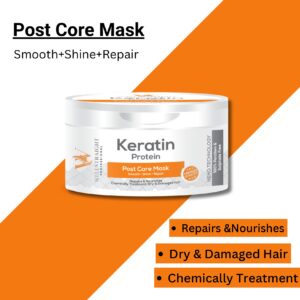In today’s world of hairstyling, heat tools and chemical treatments have become an essential part of many people’s beauty routines. These methods, from straightening irons to perming solutions and hair dyes, help achieve the perfect look but can leave hair dry, brittle, and damaged over time. Fortunately, hair repair mask serve as a powerful remedy to restore moisture, strengthen strands, and reverse damage caused by excessive styling. how hair repair masks help fix chemical and heat damage, why they are essential, and how to choose the best one for your hair.

Understanding Chemical and Heat Damage
Before diving into solutions, it’s crucial to understand the impact of chemical and heat treatments on your hair.
Chemical Damage
Chemical treatments such as hair coloring, bleaching, perming, and relaxing alter the natural structure of your hair. These processes strip away the hair’s protective cuticle, leaving strands vulnerable to breakage, split ends, and excessive dryness. The more frequently these treatments are applied, the weaker your hair becomes.
Heat Damage
Excessive use of heat-styling tools like curling irons, straighteners, and blow dryers weakens hair proteins and depletes natural moisture. High temperatures break down keratin, the protein responsible for hair strength and elasticity, leading to frizz, dullness, and breakage.
How Hair Repair Mask Work to Reverse Damage
Hair repair mask are intensive conditioning treatments designed to penetrate deeply into hair strands, replenishing lost moisture and nutrients. Unlike regular conditioners, they contain high concentrations of nourishing ingredients to provide long-lasting repair and protection. Here’s how they help:
1. Restoring Moisture and Hydration
One of the primary functions of a hair repair mask is to restore moisture levels in dry and brittle hair. Ingredients like hyaluronic acid, glycerin, and aloe vera draw in and retain moisture, leaving hair soft and manageable.
2. Repairing Protein Structure
Since hair is primarily made of keratin, exposure to heat and chemicals can weaken its natural protein bonds. Hair mask with keratin, hydrolyzed silk, and amino acids help rebuild these protein structures, making hair stronger and more resilient.
3. Sealing the Cuticle for Protection
A damaged hair cuticle results in frizz, rough texture, and split ends. Mask containing coconut oil, argan oil, and shea butter form a protective layer over the hair shaft, sealing moisture inside and preventing future damage.
4. Enhancing Elasticity and Preventing Breakage
Weakened hair is prone to breakage due to reduced elasticity. Ingredients like biotin, vitamin E, and panthenol improve flexibility, allowing hair to withstand styling without snapping or splitting.
5. Neutralizing Free Radicals and Repairing Damage
Hair exposed to chemicals and heat also suffers from oxidative stress caused by free radicals. Antioxidant-rich ingredients like green tea extract, vitamin C, and sunflower seed oil help fight these radicals, reversing damage and protecting against environmental aggressors.
Choosing the Right Hair Repair Mask

Not all hair repair mask are created equal. Selecting the right one depends on your hair type, level of damage, and specific needs. If you’re looking for a solution, a hair mask for hair growth can help nourish and strengthen your strands.
- For severely damaged hair: Look for a mask with keratin, castor oil, and ceramides to deeply repair broken bonds and restore hair structure.
- For dry and brittle hair: Opt for a mask containing shea butter, argan oil, and honey to provide intense hydration.
- For color-treated hair: Use sulfate-free mask with quinoa protein, jojoba oil, and UV protectants to maintain color vibrancy and prevent fading.
- For fine or oily hair: Lightweight mask with green tea extract, silk proteins, and aloe vera hydrate without weighing hair down.
How to Use a Hair Repair Mask for Best Results
Applying a hair repair mask correctly ensures optimal benefits. Follow these steps:
- Wash Your Hair – Cleanse hair with a sulfate-free shampoo to remove buildup and allow better absorption.
- Apply Evenly – Spread the mask from mid-lengths to ends, avoiding the scalp (unless specified for scalp use).
- Leave It On – Follow the recommended time on the packaging (typically 10–30 minutes). For deep repair, use a shower cap to generate heat and enhance penetration.
- Rinse with Cool Water – Rinsing with cool or lukewarm water seals the cuticle and locks in moisture.
- Use Consistently – For best results, apply a hair repair mask 1–2 times per week, depending on hair damage level.
Additional Tips to Prevent Hair Damage
While hair repair mask are essential for reversing damage, incorporating additional protective measures can enhance results:
- Use Heat Protectant: Apply a heat protectant spray before using hot styling tools.
- Limit Heat Styling: Reduce the use of straighteners and curling irons or opt for lower heat settings.
- Avoid Overprocessing: Space out chemical treatments to allow hair recovery time.
- Trim Regularly: Trim split ends every 6–8 weeks to maintain hair health.
- Choose Gentle Hair Products: Use sulfate-free shampoos and conditioners that won’t strip natural oils.
Conclusion
Hair repair mask are an essential solution for anyone dealing with the effects of chemical and heat damage. These intensive treatments restore hydration, strengthen hair fibers, and protect against further damage. By incorporating a high-quality hair repair mask into your routine, along with mindful hair care practices, you can bring your locks back to life—stronger, shinier, and healthier than ever.
At Well Straight Professional, we believe in the power of advanced hair care solutions to repair and protect your hair. Try our premium hair repair mask and experience the transformation for yourself!
Have you tried a hair repair mask before? Share your experiences in the comments below!
